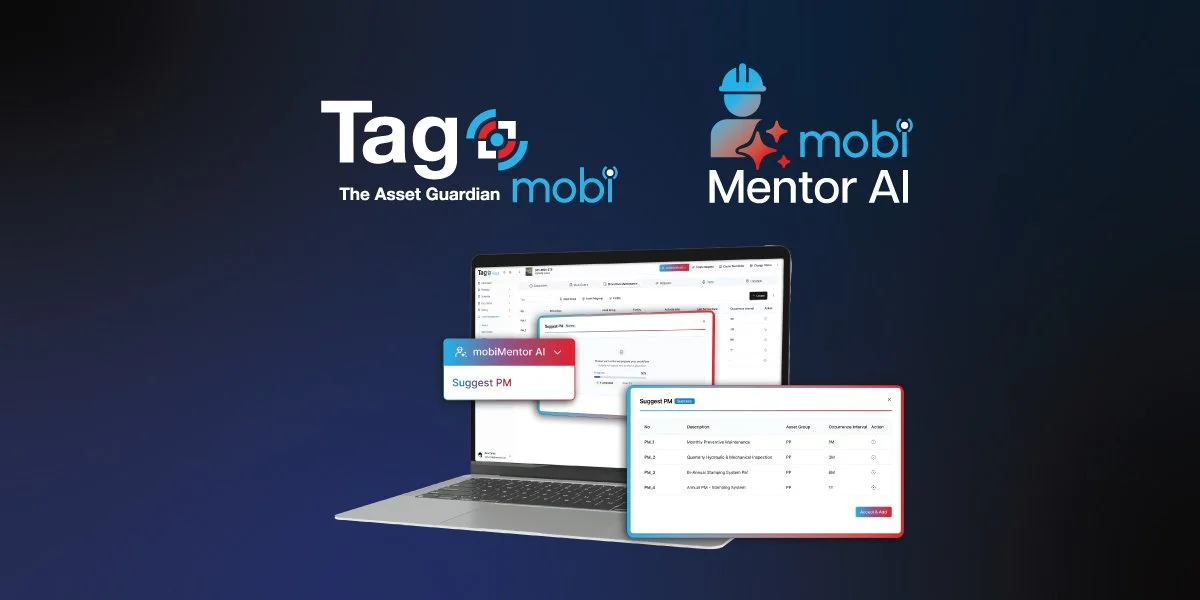Optimize Large-Scale Asset Management in Enterprises
Large enterprises handle a vast quantity of assets, each generating significant amounts of data. Keeping track of and maintaining accurate records for these assets can overwhelm organizations.
What you will learn in this article:
The biggest challenges in managing large-scale enterprise assets, including data complexity and regulatory compliance.
How CMMS/EAM systems streamline asset tracking, maintenance, and efficiency.
The role of IoT and predictive maintenance in reducing downtime and improving asset performance.
Why data integration and interoperability are essential for seamless operations.
How compliance management tools and workforce training enhance asset reliability and regulatory adherence.
Imagine running a massive machine with thousands of moving parts, each one critical to the machine’s operation. Now, imagine managing several of these machines, each producing mountains of data, requiring constant maintenance, and needing to comply with stringent regulations. This is the reality for many large enterprises today. Effective asset management is not just a necessity; it is the lifeline that keeps industries such as energy, manufacturing, power and utility, facility management, and healthcare operating smoothly. This article delves into the challenges faced in managing these vast assets and provides practical solutions to overcome them.
Identifying Major Large-Scale Asset Management Challenges
Volume and Complexity of Data
Large enterprises handle a vast quantity of assets, each generating significant amounts of data. Keeping track of and maintaining accurate records for these assets can overwhelm organizations.
Energy: Companies must track data from numerous power plants and renewable sources.
Manufacturing: Monitoring machinery and equipment across multiple locations.
Healthcare: Managing medical equipment and patient care devices.
The sheer volume of data and the complexity of managing data are significant challenges.
Integration of Diverse Systems
Integrating legacy systems with new technologies often proves difficult for large enterprises. Many organizations struggle with databases and a lack of interoperability between different systems, leading to inefficiencies and increased operational costs. For instance, a manufacturing company might have older systems that do not communicate well with newer, more advanced technologies, hindering seamless data flow and reducing overall efficiency.
Regulatory Compliance
Adhering to industry-specific requirements is crucial but challenging, particularly across multiple assets and locations. Ensuring compliance with all relevant standards is vital to avoid fines, legal issues, and operational halts. Non-compliance can lead to severe consequences, including financial penalties and reputational damage. For example, a power utility company must comply with strict environmental and safety regulations, and any lapse can result in significant penalties.
Maintenance and Downtime
Scheduling regular maintenance and handling unplanned downtime are critical aspects of asset management. However, these tasks can be complex and costly.
Impact on Productivity: Unplanned downtime severely impacts productivity and profitability.
Predicting Failures: Preventing equipment failures before they occur is a significant challenge.
For instance, unexpected machinery breakdowns in the manufacturing sector can halt production lines, leading to substantial financial losses.
Workforce Management
Managing a large and diverse workforce presents its own set of challenges. It is crucial to ensure that workers are well-trained and skilled and adhere to safety protocols. Additionally, retaining skilled workers and reducing turnover are vital for maintaining operational efficiency. For example, in facility management, effectively managing a diverse team of technicians and support staff ensures smooth operations and compliance with safety standards.
You May Be Interested In…
Tackling Large-Scale Asset Management Issues
Implementing a Robust CMMS/EAM System
Computerized Maintenance Management Systems (CMMS) and Enterprise Asset Management (EAM) systems provide centralized platforms for streamlined asset management. These systems offer numerous benefits, including improved efficiency, better data management, and enhanced decision-making.
Benefits:
Improve efficiency
Better data management
Enhanced decision-making
Leveraging IoT and Predictive Maintenance
The Internet of Things (IoT) offers **advanced asset monitoring and predictive maintenance capabilities. Leveraging IoT allows organizations to reduce downtime and extend the life of their assets through predictive analytics.
Predictive Maintenance Benefits:
Reduces downtime
Extends asset life
A prime example is Pacific Gas and Electric Company (PG&E)’s smart grid initiative, which incorporates advanced metering infrastructure (AMI) and IoT sensors. These technologies enable real-time monitoring and management of energy distribution, enhancing grid reliability. By providing detailed insights into equipment health and performance, PG&E’s system supports predictive maintenance, effectively reducing unplanned outages and maintenance costs.
Examples like PG&E demonstrate how predictive maintenance can transform large-scale asset management, leading to significant cost savings and improved operational efficiency.
Ensuring Data Integration and Interoperability
Using standardized protocols and APIs can help integrate diverse systems for seamless data flow. A unified data platform offers numerous benefits, including improved data accuracy, better decision-making, and enhanced operational efficiency.
A unified data platform centralizes information from multiple sources, leading to several key benefits:
Improve data accuracy: Consistent data integration reduces errors and inconsistencies, providing a reliable foundation for analysis and reporting.
Better Decision-Making: Access to integrated and accurate data enables more informed decisions, leading to strategic advantages and improved outcomes.
Enhanced Operational Efficiency: Streamlined data flow and system interoperability eliminate redundancies and inefficiencies, optimizing overall operations.
Successful data integration in healthcare, for example, highlights how organizations can effectively manage and utilize large volumes of data from diverse sources. For instance, electronic health records (EHR) systems integrate patient data from various departments, including lab results, imaging, and patient history. Standardized protocols and APIs enable these systems to communicate seamlessly, providing a comprehensive view of patient health. This integration supports:
Improved Patient Care: Comprehensive and up-to-date patient information allows for better diagnosis and treatment planning.
Operational Efficiency: Streamlined data flow reduces administrative overhead and enhances coordination among healthcare providers.
Data Accuracy and Security: Standardized systems and protocols ensure that patient data is accurate and protected, complying with regulatory standards.
Successful healthcare data integration addresses the challenges of managing extensive and varied data sources and serves as a model for other sectors. It demonstrates how thoughtful implementation of standardized protocols and data platforms can lead to significant improvements in operational efficiency and decision-making.
Adopting Compliance Management Tools
Industries with stringent regulatory requirements, such as healthcare and energy, can significantly benefit from adopting compliance management tools. These tools help companies maintain compliance by offering real-time monitoring, automated reporting, and centralized documentation of compliance activities. For instance, the healthcare industry can use compliance tools to ensure adherence to patient data protection laws, while the energy sector can monitor environmental regulations and safety standards.
By implementing these tools, organizations can:
Streamline compliance processes
Enhance accuracy in reporting
Quickly identify and address compliance issues
Reduce the risk of penalties
Energy companies use compliance tools to monitor and report on environmental impact, ensuring adherence to regulations such as the Clean Air Act. Real-time data collection and automated reporting streamline compliance processes, allowing for proactive management of potential violations.
Adopting these tools not only ensures compliance but also enhances operational efficiency and reduces the risk of costly penalties.
Investing in Workforce Training and Development
Regular training and certification are crucial for maintaining a skilled workforce. Digital training tools offer efficient and effective ways to provide continuous training and development opportunities for employees.
Training benefits:
Improved workforce efficiency
Enhanced operational performance
Ensured compliance with safety protocols
Improving workforce efficiency through training programs highlights the importance of investing in workforce development to enhance operational performance and ensure compliance with safety protocols.
Summing Up: Insights on Enterprise Asset Management
Managing large amounts of enterprise assets presents numerous challenges, but proactive asset management and modern solutions can help overcome these hurdles. Implementing a robust CMMS/EAM system, leveraging IoT, ensuring data integration, using compliance tools, and investing in workforce training are key strategies for success. By adopting these solutions, organizations can improve efficiency, reduce costs, and enhance overall asset management.
TAG: The Key to Superior Asset Management
With TAG by Verosoft Design, you can streamline your large-scale asset management and ensure your assets are performing at their best. Our complete solution provides real-time monitoring, predictive maintenance, and actionable insights tailored to your business needs. Contact us today for a discovery call and explore how The Asset Guardian (TAG) can transform the management of your large-scale enterprise assets, driving your business toward greater success.
Continue reading…








